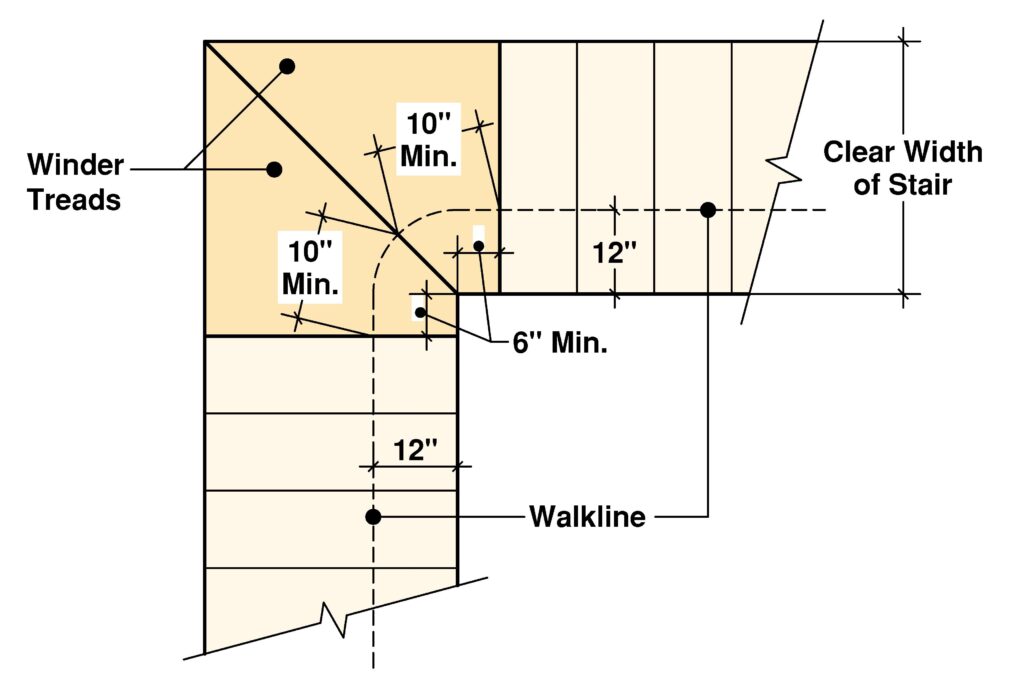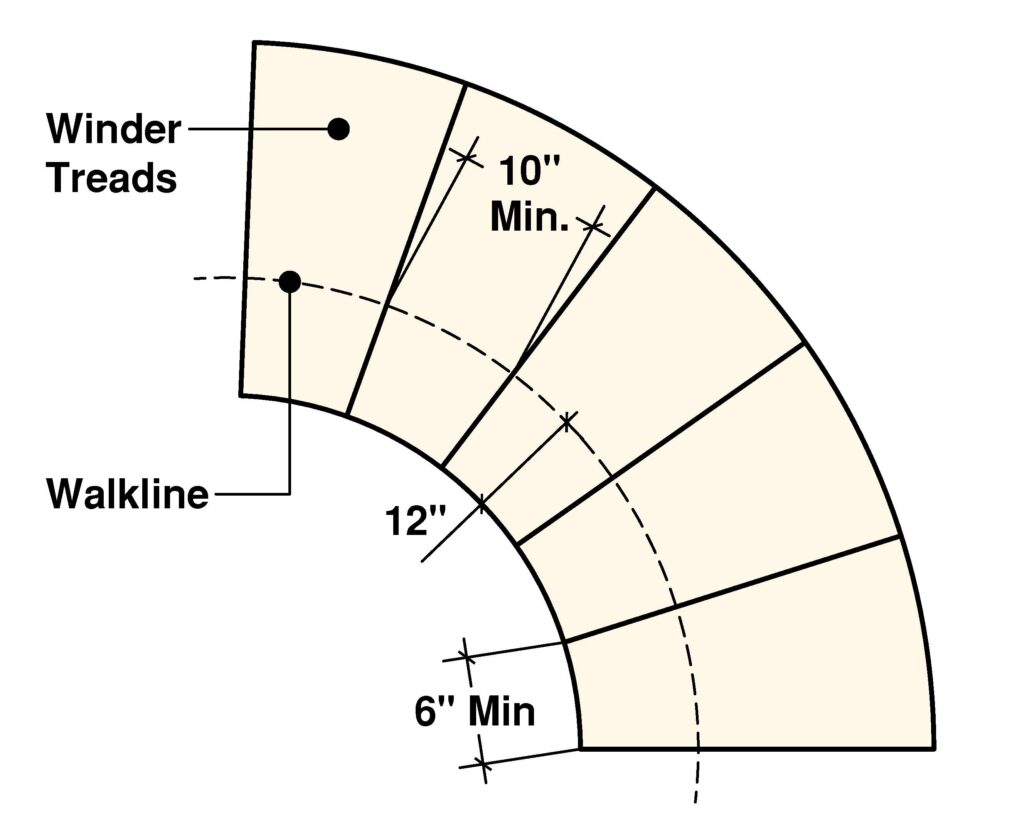A winder stair is another type of tread within a stair system that the code allows in-lieu of a traditional tread. When a winder tread is installed within an individual dwelling unit, it must comply with the International Residential Code (IRC).
To understand if a winder tread is code compliant, we need to take a look at code section R311.7.5.2.1 within the 2018 International Residential Code (IRC) to see what those requirements are.
Please note that in this post we will be looking at the code standards related to residential winder stairs in accordance with the International Residential Code (IRC). For commercial stair standards, one must look to the International Building Code (IBC).
Fun Tip: What’s the difference between the IBC and IRC? Be sure to check out this POST.
What is a Winder Tread?
First let us define what a Winder Tread is. In Chapter 2 of the IRC, the code defines a Winder Tread as the following:
Winder – A tread with nonparallel edges.
Some people might also refer to a winder tread as an angled step or stair. That term is not used in the code but as you can see the nature of it is true since the definition refers to it as a tread with nonparallel edges.
Similar to how a conventional tread is used in a staircase with a straight run, a winder tread is used in a staircase that changes in direction.
What is the Benefit of a Winder Tread?
An added benefit of using a Winder Tread in-lieu of a conventional tread is that its shape allows the user to gradually turn in the direction of the staircase while traveling up or down.
The use of a winder tread can also be helpful when a staircase is located in a limited space. If an intermediate landing is not required in a stair run but due to the staircase having to turn, a winder tread can be used instead of an enlarged tread thus requiring less floor area while reaching the same elevation.
Given such a unique shape, the code establishes dimensions for winder treads so that they can be used safely and effectively.
Therefore lets look at Section R311.7.5.2.1 of the IRC to see what those requirements are.
Winder Tread Dimensions
Winder treads shall have a tread depth of not less than 10 inches measured between the vertical planes of the foremost projection of adjacent treads at the intersections with the walkline. Winder treads shall have a tread depth of not less than 6 inches at any point within the clear width of the stair. Within any flight of stairs, the largest winder tread depth at the walkline shall not exceed the smallest winder tread by more than 3/8 inch. Consistently shaped winders at the walkline shall be allowed within the same flight of stairs as rectangular treads and shall not be required to be within 3/8 inch of the rectangular tread depth.
There’s a lot going on in this code section so lets take it step by step.
It is however important to understand that a flight of stairs can be made up of both rectangular treads and winder treads. Or another option is that a flight of stairs can be made up of only winder treads. In this case this is typically a circular stairway.
We will get into this a little later after we discuss a staircase with both rectangular treads and winder treads first. It is important to note however that circular stars are NOT considered spiral stairs. Spiral stairs have their own code section which you can read more about in THIS POST.
Winder Depth
Lets start off with the two main critical dimensions that are noted in the code section above.
A minimum 10-inch tread depth is required at the walkline and a minimum 6-inch tread depth is required at any point of the narrow side that is within the clear width of the stair.
These two dimensions are very important since these two points control the geometry of the tread.
Since the first dimension is measured from the walkline, it is best to understand where the ‘walkline’ is located along the tread. This term is not defined in the definitions but it is mentioned in the conventional stair section found in R311.7.4.
The walkline across winder treads and landings shall be concentric to the turn and parallel to the direction of travel entering and exiting the turn. The walkline shall be located 12 inches from the inside of the turn. The 12-inch dimension shall be measured from the widest point of the clear stair width at the walking surface.
As you can see, the walkline shall be located 12 inches from the inside of the turn, at the widest point of the clear stair width at the walking surface.
To best illustrate this, see the image below.

Therefore the minimum required width of the stair is measured from the point along the tread that is a minimum 6 inches in depth and the tread must have a minimum required depth of 10 inches at the walkline which is located 12 inches from the inside of the turn.
Another thing to note regarding the above code section is the tolerance it gives. When a user travels up or down a flight of stairs, the turning of each winder tread should be consistent through the turn. If there is any variation, the code allows a tolerance of no more than 3/8 of an inch.
This means that the largest winder tread depth shall not differ from the smallest winder tread depth within a flight of stairs by more than 3/8 of an inch.
Winder Treads in Circular Stairs
A circular or curved stairway is basically made up of winder treads. These type of stairs typically do not have a straight portion in it like the example we saw above but instead curve throughout the entire flight which results in the treads having nonparallel edges.
For this the same dimensions noted above still apply as well as the same stair standards used for conventional stairs. The only difference from a conventional stair is the tread.
To best illustrate this, see the image below.

The same sections regarding tolerance in tread sizes apply here as well where the largest winder tread depth shall not differ from the smallest winder tread depth within a flight of stairs by more than 3/8 of an inch.
Again it is important to note here that curved stairs are not spiral stairs. Spiral Staircases have a completely different set of requirements that are found in Section R311.7.10.1.
To learn about Spiral Staircase requirements, be sure to check out THIS POST for an explanation.
So this sums up the basic code requirements for winder treads used within residential dwelling units that are subject to the International Residential Code (IRC).
.
* Reference Source – 2018 International Residential Code – [Buy on Amazon]
.
Related Articles to Read:
